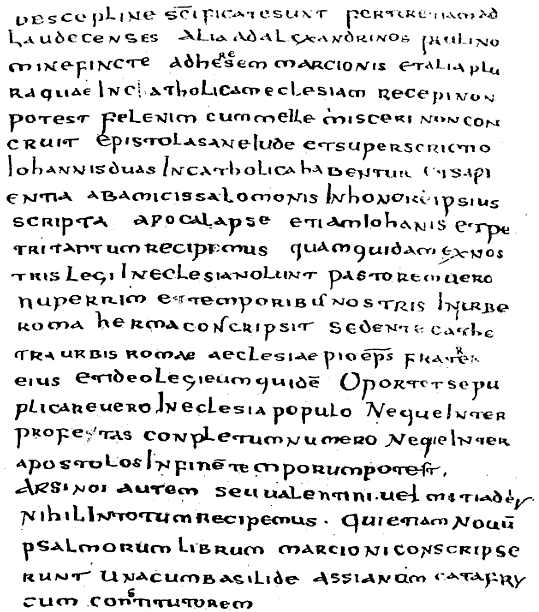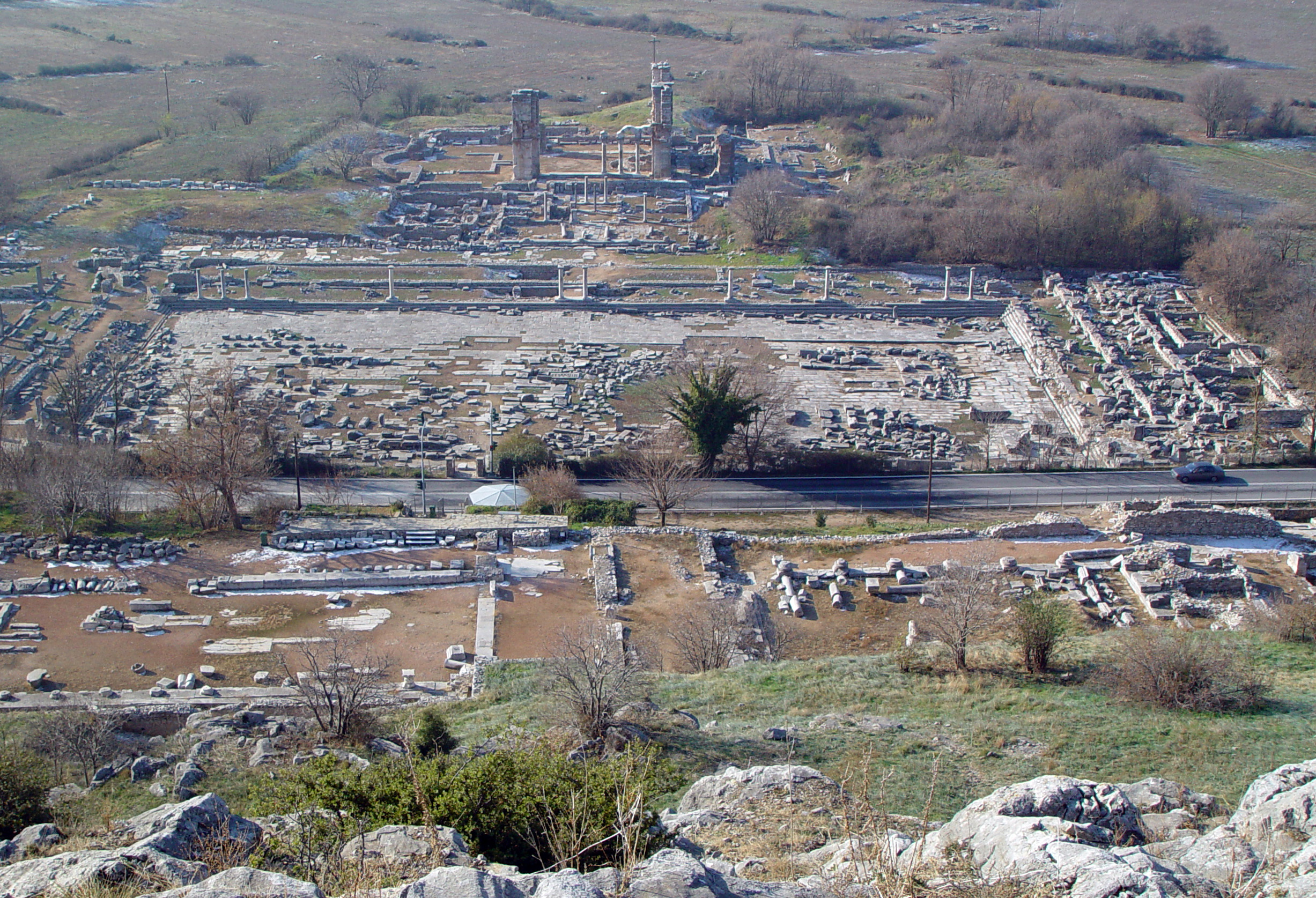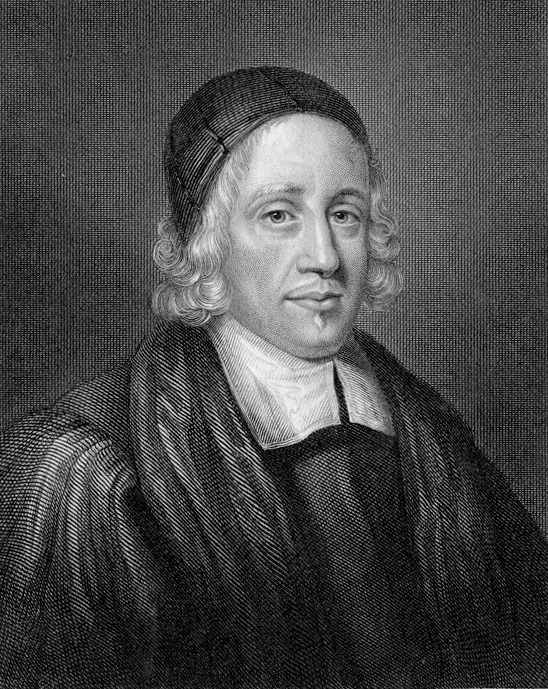|
Laodiceans
The Epistle to the Laodiceans is a letter of Paul the Apostle, the original existence of which is inferred from an instruction to the congregation in Colossae to send their letter to the believing community in Laodicea, and likewise obtain a copy of the letter "from Laodicea" ( gr, ἐκ Λαοδικείας, ''ek Laodikeas''). This letter is generally regarded as being lost. However, some ancient sources, such as Hippolytus, and some modern scholars consider that the epistle "from Laodicea" was never a lost epistle, but simply Paul re-using one of his other letters (the most common candidate is the canonical Epistle to the Ephesians), just as he asks for the copying and forwarding of the Letter to Colossians to Laodicea. Several ancient texts purporting to be the missing "Epistle to the Laodiceans" have been known to have existed, most of which are now lost. These were generally considered, both in antiquity and by modern scholarship, to be attempts to supply a forged copy ... [...More Info...] [...Related Items...] OR: [Wikipedia] [Google] [Baidu] |
Marcionism
Marcionism was an early Christian dualistic belief system that originated with the teachings of Marcion of Sinope in Rome around the year 144. Marcion was an early Christian theologian, evangelist, and an important figure in early Christianity. He was the son of a bishop of Sinope in Pontus. About the middle of the 2nd century (140–155) he traveled to Rome, where he joined the Syrian Gnostic Cerdo. Marcion preached that the benevolent God of the Gospel who sent Jesus Christ into the world as the savior was the true Supreme Being, different and opposed to the malevolent Demiurge or creator god, identified with the Hebrew God of the Old Testament. He considered himself a follower of Paul the Apostle, whom he believed to have been the only true apostle of Jesus Christ. Marcion's canon, possibly the first Christian canon ever compiled, consisted of eleven books: a gospel, which was a shorter version of the Gospel of Luke, and ten Pauline epistles. Marcion's canon rejected th ... [...More Info...] [...Related Items...] OR: [Wikipedia] [Google] [Baidu] |
Bible Canon
A biblical canon is a set of texts (also called "books") which a particular Jewish or Christian religious community regards as part of the Bible. The English word ''canon'' comes from the Greek , meaning "rule" or "measuring stick". The use of the word "canon" to refer to a set of religious scriptures was first used by David Ruhnken, in the 18th century. Various biblical canons have developed through debate and agreement on the part of the religious authorities of their respective faiths and denominations. Some books, such as the Jewish–Christian gospels, have been excluded from various canons altogether, but many disputed books are considered to be biblical apocrypha or deuterocanonical by many, while some denominations may consider them fully canonical. Differences exist between the Hebrew Bible and Christian biblical canons, although the majority of manuscripts are shared in common. Different religious groups include different books in their biblical canons, in varying ... [...More Info...] [...Related Items...] OR: [Wikipedia] [Google] [Baidu] |
New Testament
The New Testament grc, Ἡ Καινὴ Διαθήκη, transl. ; la, Novum Testamentum. (NT) is the second division of the Christian biblical canon. It discusses the teachings and person of Jesus, as well as events in first-century Christianity. The New Testament's background, the first division of the Christian Bible, is called the Old Testament, which is based primarily upon the Hebrew Bible; together they are regarded as sacred scripture by Christians. The New Testament is a collection of Christian texts originally written in the Koine Greek language, at different times by various authors. While the Old Testament canon varies somewhat between different Christian denominations, the 27-book canon of the New Testament has been almost universally recognized within Christianity since at least Late Antiquity. Thus, in almost all Christian traditions today, the New Testament consists of 27 books: * 4 canonical gospels (Matthew, Mark, Luke, and John) * The Acts of the Apostl ... [...More Info...] [...Related Items...] OR: [Wikipedia] [Google] [Baidu] |
Muratorian Fragment
The Muratorian fragment, also known as the Muratorian Canon (Latin: ), is a copy of perhaps the oldest known list of most of the books of the New Testament. The fragment, consisting of 85 lines, is a 7th-century Latin manuscript bound in a 7th- or 8th-century codex from the library of Columbanus's monastery at Bobbio Abbey; it contains features suggesting it is a translation from a Greek original written about 170 or as late as the 4th century. Both the degraded condition of the manuscript and the poor Latin in which it was written have made it difficult to translate. The beginning of the fragment is missing, and it ends abruptly. The fragment consists of all that remains of a section of a list of all the works that were accepted as canonical by the churches known to its original compiler. During the time period of early Christianity, there was no accepted "New Testament", merely books considered of greater or lesser value. While likely not intended strictly as a canon list, th ... [...More Info...] [...Related Items...] OR: [Wikipedia] [Google] [Baidu] |
Laodicea On The Lycus
Laodicea on the Lycus ( el, Λαοδίκεια πρὸς τοῦ Λύκου ''Laodikia pros tou Lykou''; la, Laodicea ad Lycum, also transliterated as ''Laodiceia'' or ''Laodikeia'') (modern tr, Laodikeia) was an ancient city in Asia Minor, now Turkey, on the river Lycus (river of Phrygia), Lycus (Çürüksu). It was located in the Hellenistic regions of Caria and Lydia, which later became the Roman Province of Phrygia Pacatiana. It is now situated near the modern city of Denizli. Since 2002 archaeology has been continuing by Pamukkale University in Denizli followed by intensive restoration work. In 2013 the archaeological site was inscribed in the Tentative List of World Heritage Sites in Turkey. It contained one of the Seven churches of Asia mentioned in the Book of Revelation. Location Laodicea is situated on the long spur of a hill between the narrow valleys of the small rivers Asopus and Caprus, which discharge their waters into the Lycus. It lay on a major trade r ... [...More Info...] [...Related Items...] OR: [Wikipedia] [Google] [Baidu] |
Epistle To The Ephesians
The Epistle to the Ephesians is the tenth book of the New Testament. Its authorship has traditionally been attributed to Paul the Apostle but starting in 1792, this has been challenged as Deutero-Pauline, that is, pseudepigrapha written in Paul's name by a later author strongly influenced by Paul's thought, probably "by a loyal disciple to sum up Paul's teaching and to apply it to a new situation fifteen to twenty-five years after the Apostle's death".Authenticity oEphesians Bible apologetics. Hoehner, Harold. ''Ephesians: An Exegetical Commentary.'' Baker Academic, 2002. Brown, Raymond E. ''The churches the apostles left behind'', Paulist Press, 1984. . Themes According to New Testament scholar Daniel Wallace, the theme may be stated pragmatically as "Christians, get along with each other! Maintain the unity practically which Christ has effected positionally by his death."Wallace, Daniel B "Ephesians:Introduction, Argument, and Outline."Bible.org, 1 January 2010 Another majo ... [...More Info...] [...Related Items...] OR: [Wikipedia] [Google] [Baidu] |
Codex Fuldensis
The Codex Fuldensis, also known as the Victor Codex (Hessian State Library, ''Codex Bonifatianus I''), designated by F, is a New Testament manuscript based on the Latin Vulgate made between 541 and 546. The codex is considered the second most important witness to the Vulgate text; and is also the oldest complete manuscript witness to the order of the Diatessaron. It is an important witness in any discussion about the authenticity of 1 Corinthians 14:34-35Philip B. Payne''Fuldensis, Sigla for Variants in Vaticanus and 1 Cor 14.34-5'' NTS 41 (1995) 251-262. and the Comma Johanneum. It is one of the earliest dated manuscripts of the New Testament. It was corrected until 2 May, 546 AD. Description It contains the Diatessaron and 23 canonical books of the New Testament; plus the Epistle to the Laodiceans, and a copy of Jerome's ''Prologue to the Canonical Gospels''. It represents the Italian type of text. The four gospels are harmonised into a single continuous narrative, accordin ... [...More Info...] [...Related Items...] OR: [Wikipedia] [Google] [Baidu] |
Paul The Apostle
Paul; grc, Παῦλος, translit=Paulos; cop, ⲡⲁⲩⲗⲟⲥ; hbo, פאולוס השליח (previously called Saul of Tarsus;; ar, بولس الطرسوسي; grc, Σαῦλος Ταρσεύς, Saũlos Tarseús; tr, Tarsuslu Pavlus; la, Paulus Tarsensis AD), commonly known as Paul the Apostle and Saint Paul, was a Christian apostle who spread the teachings of Jesus in the first-century world. Generally regarded as one of the most important figures of the Apostolic Age, he founded several Christian communities in Asia Minor and Europe from the mid-40s to the mid-50s AD. According to the New Testament book Acts of the Apostles, Paul was a Pharisee. He participated in the persecution of early disciples of Jesus, possibly Hellenised diaspora Jews converted to Christianity, in the area of Jerusalem, prior to his conversion. Some time after having approved of the execution of Stephen, Paul was traveling on the road to Damascus so that he might find any Christians ... [...More Info...] [...Related Items...] OR: [Wikipedia] [Google] [Baidu] |
Epistle To The Philippians
The Epistle to the Philippians is a Pauline epistle of the New Testament of the Christian Bible. The epistle is attributed to Paul the Apostle and Timothy is named with him as co-author or co-sender. The letter is addressed to the Christian church in Philippi. Paul, Timothy, Silas (and perhaps Luke) first visited Philippi in Greece ( Macedonia) during Paul's second missionary journey from Antioch, which occurred between approximately 49 and 51 AD. In the account of his visit in the Acts of the Apostles, Paul and Silas are accused of "disturbing the city". There is a general consensus that Philippians consists of authentically Pauline material, and that the epistle is a composite of multiple letter fragments from Paul to the church in Philippi. These letters could have been written from Ephesus in 52–55 AD or Caesarea Maritima in 57–59, but the most likely city of provenance is Rome, around 62 AD, or about 10 years after Paul's first visit to Philippi. Harris, Stephen L., Un ... [...More Info...] [...Related Items...] OR: [Wikipedia] [Google] [Baidu] |
John Lightfoot
John Lightfoot (29 March 1602 – 6 December 1675) was an English churchman, rabbinical scholar, Vice-Chancellor of the University of Cambridge and Master of St Catharine's College, Cambridge. Life He was born in Stoke-on-Trent, the son of Thomas Lightfoot, vicar of Uttoxeter, Staffordshire. He was educated at Morton Green near Congleton, Cheshire, and at Christ's College, Cambridge, where he was regarded as the best orator among the undergraduates. After taking his degree he became assistant master at Repton School in Derbyshire; after taking orders, he was appointed curate of "Norton-under-Hales" (i.e. Norton in Hales) in Shropshire. There he attracted the notice of Sir Rowland Cotton, an amateur Hebraist, who made him his domestic chaplain at Bellaport. Shortly after the removal of Sir Rowland to London, Lightfoot, abandoning an intention to go abroad, accepted a charge at Stone, Staffordshire, where he continued for about two years. From Stone he removed to Hornsey, ... [...More Info...] [...Related Items...] OR: [Wikipedia] [Google] [Baidu] |
Fenton John Anthony Hort
Fenton John Anthony Hort (1828–1892), known as F. J. A. Hort, was an Irish-born theologian and editor, with Brooke Foss Westcott of a critical edition of ''The New Testament in the Original Greek''. Life He was born on 23 April 1828 in Dublin, the great-grandson of Josiah Hort, Archbishop of Tuam in the eighteenth century. In 1846 he passed from Rugby School to Trinity College, Cambridge, where he was the contemporary of E. W. Benson, B. F. Westcott and J. B. Lightfoot. The four men became lifelong friends and fellow-workers. In 1850 Hort took his degree, being third in the classical ''tripos''. In 1851 he also took the recently established triposes in moral science and natural science, and in 1852 he became fellow of his college. In 1854, in conjunction with John E. B. Mayor and Lightfoot, he established the ''Journal of Classical and Sacred Philology'', and plunged eagerly into theological and patristic study. He had been brought up in ... [...More Info...] [...Related Items...] OR: [Wikipedia] [Google] [Baidu] |
Epistle To Philemon
The Epistle to Philemon is one of the books of the Christian New Testament. It is a prison letter, co-authored by Paul the Apostle with Timothy, to Philemon, a leader in the Colossian church. It deals with the themes of forgiveness and reconciliation. Paul does not identify himself as an apostle with authority, but as "a prisoner of Jesus Christ", calling Timothy "our brother", and addressing Philemon as "fellow labourer" and "brother" (). Onesimus, a slave that had departed from his master Philemon, was returning with this epistle wherein Paul asked Philemon to receive him as a "brother beloved" (). Philemon was a wealthy Christian, possibly a bishop of the house church A house church or home church is a label used to describe a group of Christians who regularly gather for worship in private homes. The group may be part of a larger Christian body, such as a parish, but some have been independent groups that see ... that met in his home () in Colossae. This letter is n ... [...More Info...] [...Related Items...] OR: [Wikipedia] [Google] [Baidu] |







.jpg)


